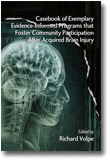
Casebook of Exemplary Evidence-Informed Programs that Foster Community Participation After Acquired Brain Injury
By:
Richard Volpe, University of Toronto
Published 2013
Acquired brain injury (ABI) describes damage to the brain that occurs after birth, caused by traumatic injury such as an accident or fall, or by non-traumatic cause such as substance abuse, stroke, or disease. Today’s medical techniques are improving the survival rate for people of all ages diagnosed with ABI, and current trends in rehabilitation are supporting these individuals returning to live, attend school, and work in their communities. Yet strategies on the best way of providing community participation vary among rehabilitation experts. Because many of survivors of ABI do not and will not return to the status quo of their former lives it is important to examine what constitutes best and promisingpractices in this area.
This casebook is the world’s first compilation of evidence-informed programs that foster community participation for people of all ages with brain injury. With thisreview, we elicited and carefully examined existing programmatic efforts that combine emphasis on the individual, the social, and the service systems in a way that captures community participation as a complex process of interactive change in the person-environment relationship – programs that do not divorce ABI survivors from their contexts, and where participation efforts facilitate positive change in the social and political context. We considered community-based programs to be programs where individuals and families actively participate in their own therapy (rehabilitation) and take responsibility for their own health or that of a family/community member.
Each case study chapter depicts a program chosen on its extraordinary merits to provide community participation to its clients. The chapters are cowritten by the stakeholder and a researcher, giving a complete perspective of how the program was established and continues to operate, and provides evidence of excellence.
CONTENTS
Acknowledgments. 1 Introduction, Richard Volpe. 2 communityworks, inc, Amanda Stewart. 3 Brain Injury Clubhouse, Cornerstone and Side by Side Brain Injury Clubhouse, Tanya Morton. 4 Skills To Enable People and Communities (STEPS) Program, Kelsey Ragan. 5 A Simply Self-Sustaining System, Community Based Reintegration Post Acute Brain Injury Program, Natasha Jamal. 6 Community Head Injury Resource Services (CHIRS), Danielle Hryniewicz. 7 The Community Approach to Participation (CAP) Model for Community Integration in People with Acquired Brain Injury, Helen Looker. 8 ABI Partnership Project—Highlighting Aboriginal ABI Community Support Program and Outreach Teams, Heather Finch. 9 Acquired Brain Injury Ireland, Georgios Fthenos and Danielle Hryniewicz. 10 School Transition and re-Entry Program (STEP), Sherry L. Ally. 11 Pediatric Acquired Brain Injury Community Outreach Program, Georgios Fthenos and Danielle Hryniewicz. 12 The Challenge Program—TIRR Memorial Hermann, Natasha Jamal. 13 The Krempels Center, Jami-Leigh Sawyer. 14 Biscayne Institutes of Health & Living Inc, Gaayathiri Jegatheeswaran. 15 The Brain Integration Programme, Negar Ahmadi. 16 Insights About Community Participation After ABI, Richard Volpe. Appendix A: BRIO Summaries. Appendix B: Life Space Summaries. Index.
-
Paperback9781623962890
Web price: $45.04 (Reg. 52.99)
-
Hardcover9781623962906
Web price: $80.74 (Reg. 94.99)
- eBook9781623962913

-
 Distance Learning
Volume 20 #3
Distance Learning
Volume 20 #3
-
 Distance Learning
Volume 20 #4
Distance Learning
Volume 20 #4
-
 Distance Learning
Volume 19 #4
Distance Learning
Volume 19 #4
-
 Distance Learning
Volume 20 #1
Distance Learning
Volume 20 #1
-
 Lift Every Voice
Radford University Teacher Education Students
Lift Every Voice
Radford University Teacher Education Students
-
 Middle Grades Research Journal
Volume 13 #2
Middle Grades Research Journal
Volume 13 #2
-
 Rekindling Embers of the Soul
An Examination of Spirituality Issues Relating to Teacher Education
Rekindling Embers of the Soul
An Examination of Spirituality Issues Relating to Teacher Education

